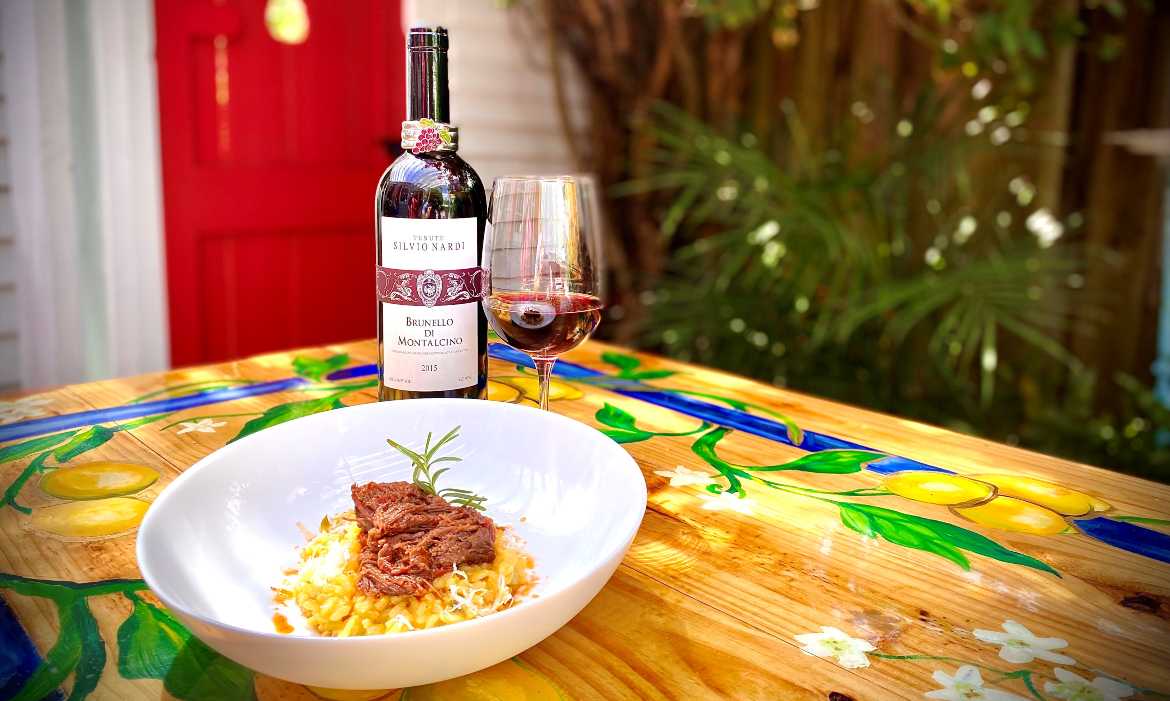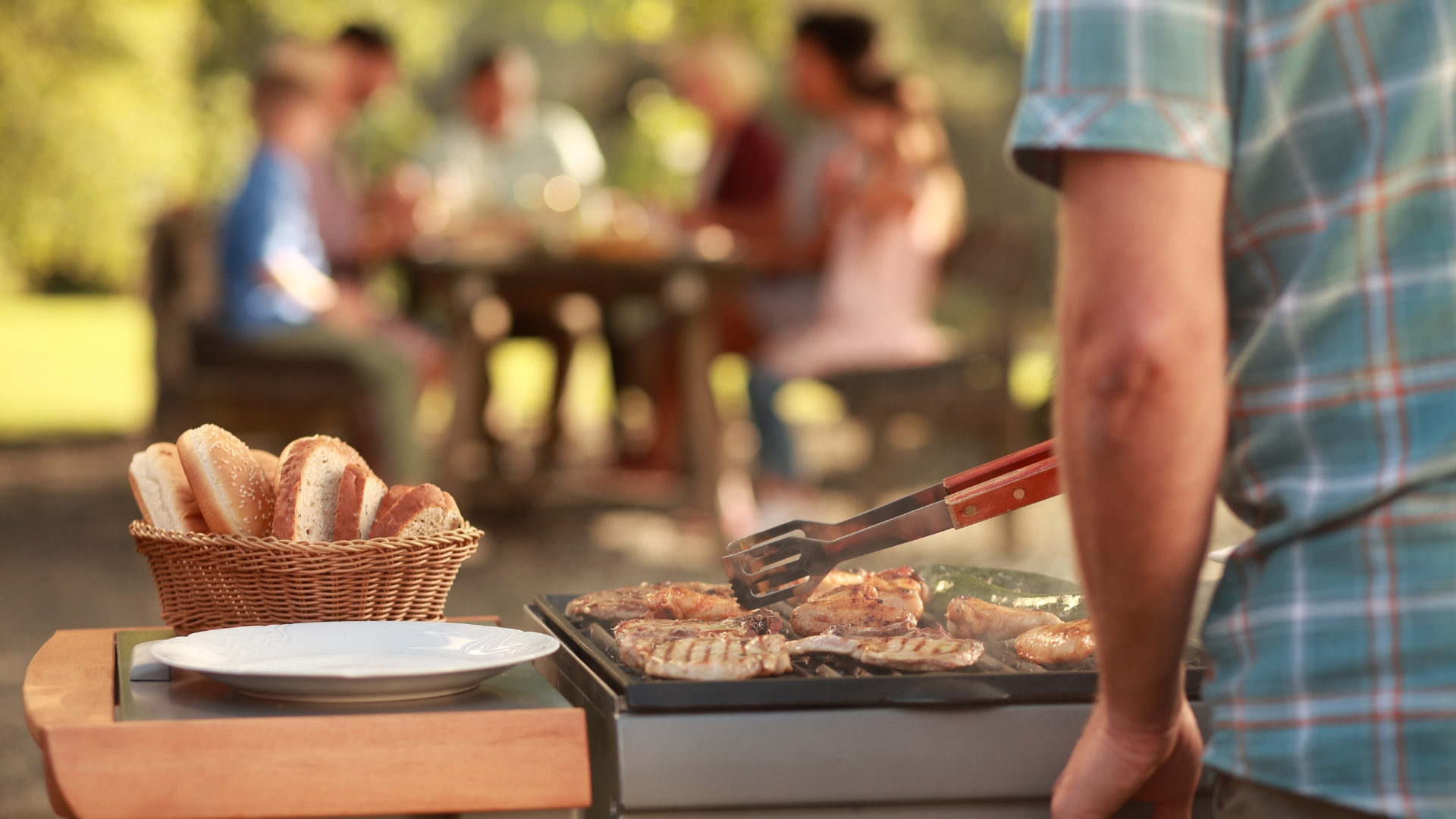One of the many Italian dishes I have always loved making is short ribs ragù. Ragù is Italian for meat sauce (actually, more like a stew). This sauce varies in form and texture within Italy’s regions, but they generally share the traits of being tomato-based sauces with some kind of meat and are traditionally served with pasta.
For this posting, I am basing my ragù on the southern Italian region style alla Napoletana, which is based on a long, bone-on braising followed by removing the meat from the bones when thoroughly cooked and tender. The end product makes for a hearty, flavor-packed shredded meat sauce that goes beautifully on top of an asparagus risotto.
A distinctive meal such as this merits a supple, complex, lingering, and structured wine such as a Brunello di Montalcino, where its Tuscan Sangiovese grapes complement the nuances of the ragù and risotto—boldly, yet with finesse, such as Tenute Silvio Nardi Brunello di Montalcino DOCG.
Let‘s get cooking!
Menu:
Carlos’ short ribs ragù
Asparagus risotto
Lemon-lavender olive oil ricotta cake
Wine pairing:
2015 Tenute Silvio Nardi Brunello di Montalcino DOCG (Montalcino, Tuscany, Italy)
Short Ribs Ragù
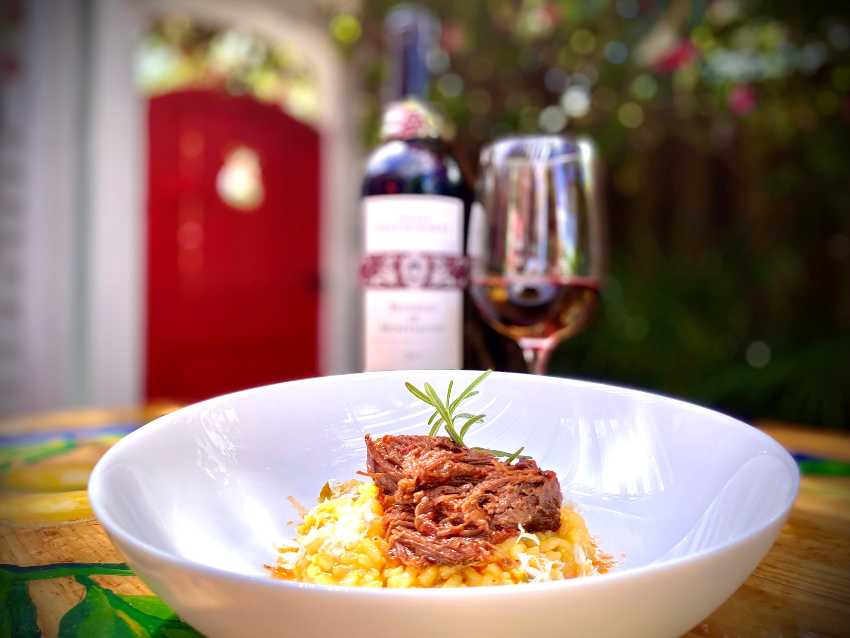
Serves 6
Ingredients
- 4-6 pounds of beef short ribs
- 3 tablespoons extra virgin olive oil, divided
- 2 large yellow onions, finely julienne sliced
- 8 cloves garlic, finely chopped
- 6 ounces fresh tomatoes, coarsely chopped
- 1 cup of red wine
- one (1) 0.75-ounce package fresh “poultry herb blend” (or approx. 2 sprigs fresh rosemary, 4 sprigs fresh sage leaves & 12 sprigs fresh thyme tied together)
- 2 bay leaves
- 1 (28 ounce) can of San Marzano tomatoes
- 2 cups low-sodium beef broth/stock or water
- Sea salt & ground black pepper, to season
Directions
- Brown the short ribs: Add the olive oil to a large, heavy-bottomed pot (I use a 5-qt Dutch oven) over medium-high heat. Use paper towel to pat the surface of the beef short ribs as dry as possible.
- Generously season the short ribs with 1 heaping tablespoon sea salt and ground black pepper as desired.
- Once the oil in the pot is shimmering hot, carefully add in the seasoned short ribs. Work in batches, as necessary, to avoid overcrowding the pot (which prevents browning). Cook for 3-4 minutes per side, until nicely browned.
- Transfer the browned short ribs to a plate and set aside. Repeat, as necessary, with the remaining short ribs.
- Once all of the short ribs are browned, carefully drain off all but 2 tablespoons drippings from the pot. Set aside and discard once cooled. Return the pot to low-medium heat.
- Add the onions to the same pot used to brown the short ribs, seasoning with 1 teaspoon sea salt and ground black pepper as desired. Stir to combine and cook, stirring occasionally, until the onions are almost caramelized, 15-20 minutes.
- Add aromatics. Add the garlic to the pot with the onions. Stirring constantly, cook until fragrant, 1-2 minutes. Add the fresh tomatoes to the pot, stirring to coat the onions. Cook 2-3 minutes until browned.
- Deglaze: Increasing the heat to medium-high, pour the red wine into the pot. Stir constantly, using a wooden spoon to scrape up any browned bits that may have formed at the bottom of the pot. Cook for 3-4 minutes, until the wine is almost completely absorbed into the onions.
- Build and simmer the short rib ragù: Tie the herbs together using kitchen twine (or finely chop if you do not have twine), then add to the pot with the bay leaves and parmesan rind (if using). Add the San Marzano tomatoes, beef broth/stock (or water), and browned short ribs. Stir to combine. Bring the mixture to a boil.
- Reduce heat to a low. Cover and simmer, stirring occasionally, for 2 1/2 – 3 hours, or until the short ribs are fall-apart tender. If the ragù begins to reduce too much (i.e. it loses too much of its liquid too quickly), feel free to add in a splash more water and/or reduce the heat further.
- Finish the braised short rib ragù: Carefully transfer the short ribs to a plate or cutting board. At this point, you can remove and discard the spent herbs, and bay leaves as well. Use tongs or two forks to shred the short ribs into bite-sized pieces, discarding the bones as you go. Return the shredded short ribs to the pot with the ragù. Stir to combine.
Asparagus Risotto
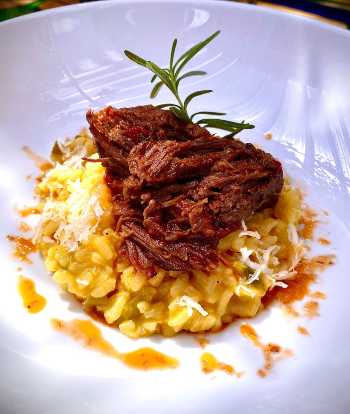
Ingredients
- 4 cups of vegetable broth or stock*
- 2 Tbsp unsalted butter
- 1/2 cup chopped shallots
- 1 cup Arborio rice
- 1/2 teaspoon of saffron
- 1/4 cup dry white wine
- 1/2 pound asparagus, trimmed, tips cut off and the spears cut into thin disks
- 1/2 cup freshly grated Parmigiano-Reggiano or Grana Padano cheese
Directions
- In a large sauce pan, on medium heat, melt 1 tablespoon of butter and cook shallots until they soften. Add the saffron and stir.
- Add rice and continue to cook on medium heat for a minute or two.
- Add the white wine. Slowly stir, allowing the rice to absorb the wine.
- Add the vegetable stock, 1/2 cup at a time (only adding after the previous addition has been absorbed by the rice). Continue to stir until the liquid is almost completely absorbed. Stir often to prevent the rice from sticking to the bottom of the pan.
- Continue cooking and stirring rice, adding a little bit of broth at a time, cooking and stirring until it is absorbed, until the rice is tender but still firm to the bite, about 20-25 minutes.
- Along with what is left of the stock, add the asparagus. Stir and cook for a couple of minutes until the risotto has absorbed the stock, but is still loose, and the asparagus is just cooked through.
- Stir in the cheese and remaining 1 tablespoon of butter. Turn off the heat. Serve immediately.
*Note: the stock amount suggested is an approximate measurement. You may need a little more or less. If you end up needing more stock and find yourself without it, just add water.
Lemon-Lavender Cake
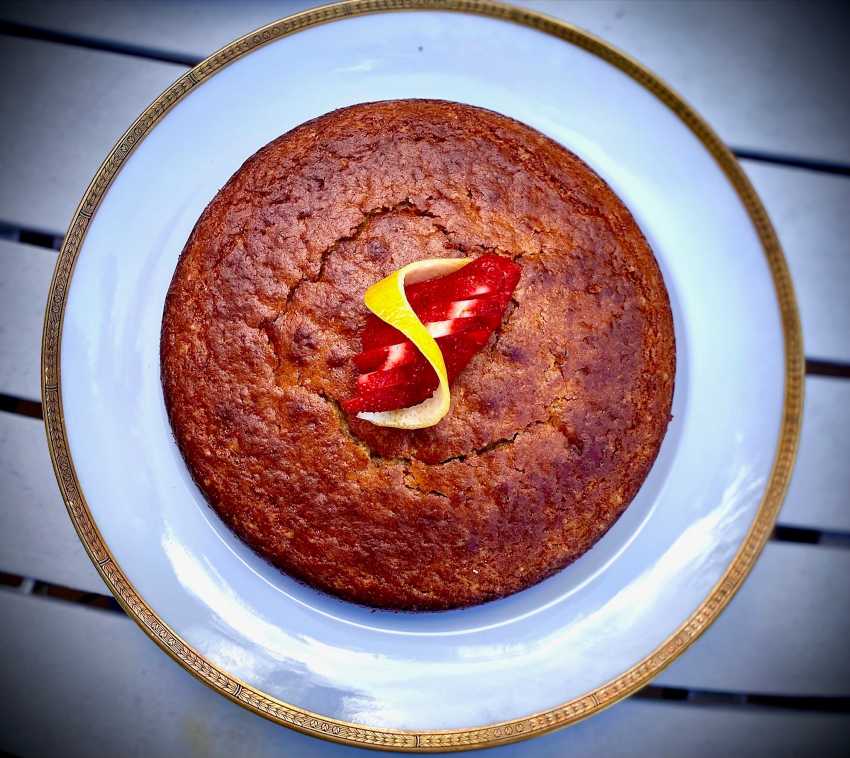
Ingredients
- 1 ½ cups of ricotta
- 2/3 cup of olive oil
- 1 ½ cups of sugar
- zest and juice of 2 lemons
- 3 eggs
- 1 ½ cups all-purpose flour
- 3/4 cup of almond meal/flour
- 1 tbl baking powder
- 1/3 tsp soda
- ¾ salt
- 1/4 teaspoon or two droplets of lavender oil
Cake decoration/garnish:
- One large strawberry, sliced in parts, 1/8 inch apart, 3/4 ways through and opened like a fan.
- A thin strip of lemon zest, twisted in a “S” shape curve.
- Powdered sugar (optional)
Directions
- Preheat oven to 350° F.
- In a large mixing bowl, whisk the ricotta, olive oil, sugar, and zest until completely combined.
- Next, add in one egg at a time until they are completely mixed in.
- In a separate large bowl, whisk together the flour, almond meal, baking powder, baking soda, and salt until combined. Whisk well to ensure any clumps are removed.
- Transfer the dry ingredients into your wet ingredients and whisk together just until everything is combined. Add lavender oil. Mix well.
- Pour the batter into a 9″ spring form pan and bake for 60-70 minutes or until browned on top and firm in the center.
- Place the cake onto a cooling rack and let it cool to room temperature (could take up to two hours) before decorating and serving.
Cake decoration:
- Once cake has cooled off, dust generously with powder sugar, and top with sliced fanned strawberry and arrange curved lemon zest on the strawberry or simply just top cake with strawberry and lemon slice without the powdered sugar.
Serve it up!
The plating and presentation for this savory dish doesn’t get much simpler than this. You’re literally putting one element on top of the other. Naturally, you want to do this nicely and in the right proportions to truly maximize the flavors and textures of the meal.
Spoon a generous heap of risotto in the middle of a large bowl (about 1/2 a cup) and add about 4 to 6 tablespoons of the shredded ragù on top of the risotto, nestled like a small mountain, where you can still see the risotto around it.
Garnish with freshly grated Parmesan cheese and cracked pepper on top and around the dish. A nice final touch can also be lightly spooning the ragù juices around the dish.
Buon appetito! Enjoy!
About the Wine Pairing: Brunello from Tuscany
Tenute Silvio Nardi’s classic Brunello is a blend of the finest grapes from the Manachiara and Casale del Bosco estates. Silvio Nardi follows the strict DOCG laws required of a classified Brunello di Montalcino. Yield is limited; only the top 70% of the grapes is used to make the wine.
The fruit is carefully handpicked and sorted. Fermentation and maceration takes at least 24 days (varies with parcel) at controlled temperature of less than 86°F. The wine is aged for 12 months in new and used French oak barriques (Allier) before 18 months in large Slavonian oak barrels. It is then bottle-aged at least 12 months before release.
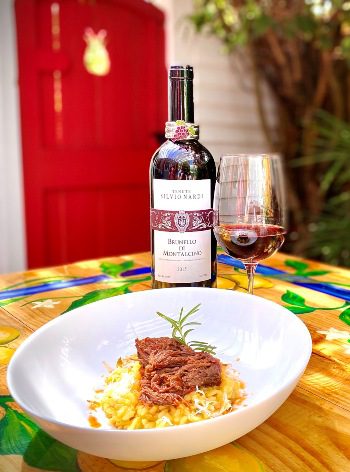
2015 Tenute Silvio Nardi Brunello di Montalcino DOCG
(Montalcino, Tuscany, Italy)
- Deep winy red color, with the characteristic bouquet of fresh red fruit.
- Great tannic structure on the palate, with an excellent acidic framework.
- A wine with an excellent, lingering aromatic persistency in the nose and in the mouth.
- 100% Sangiovese
Sangiovese has aromas of black cherries with alluring wood, smoke, tar, and herbal notes. The best wines made from this grape have incredible complexity, depth, finesse, and power.
Food pairing: This fine wine pairs beautifully with hearty dishes such as steak, game dishes with mushrooms, stews, heavy pasta dishes and powerful cheeses.
Accolades:
- 94 Points Jamessuckling.com
- 94 Points Wine Advocate
